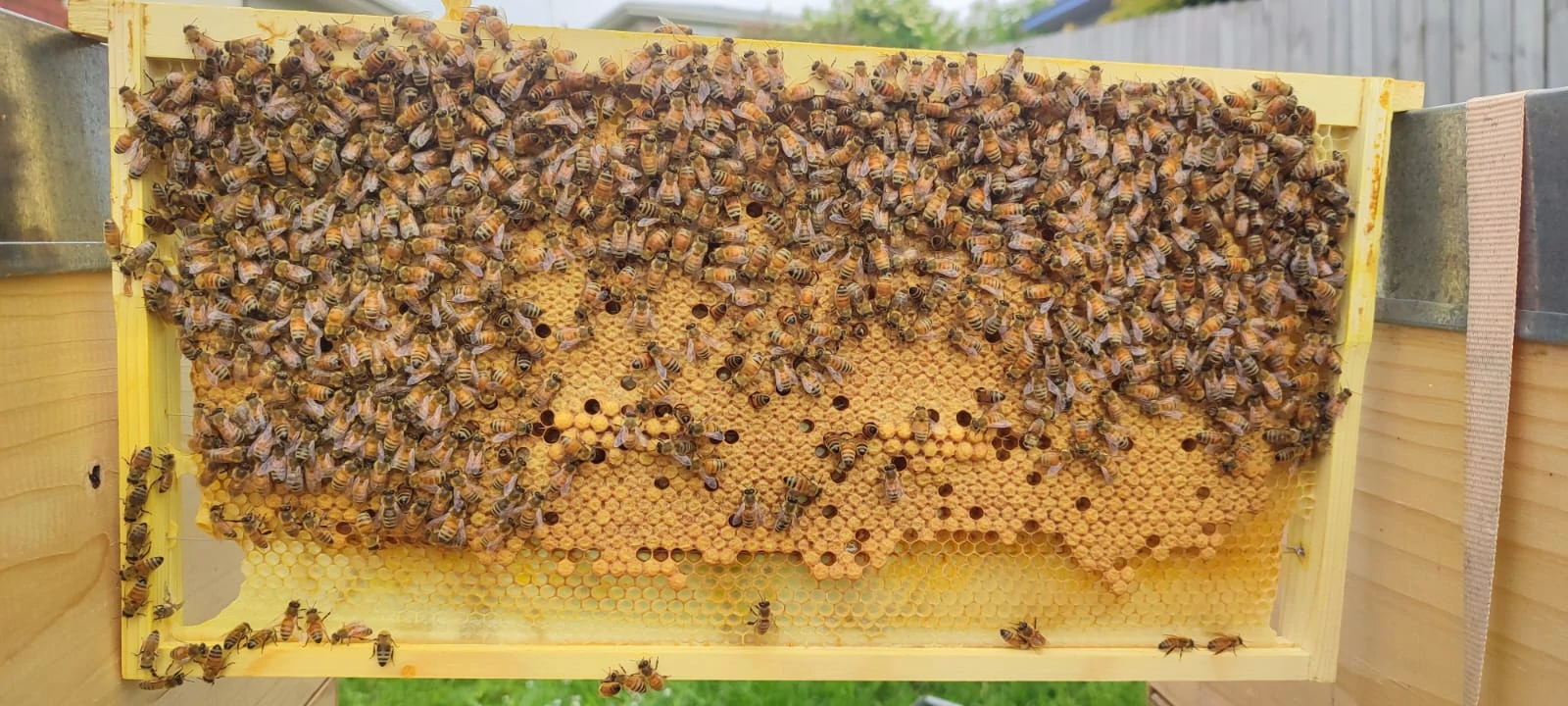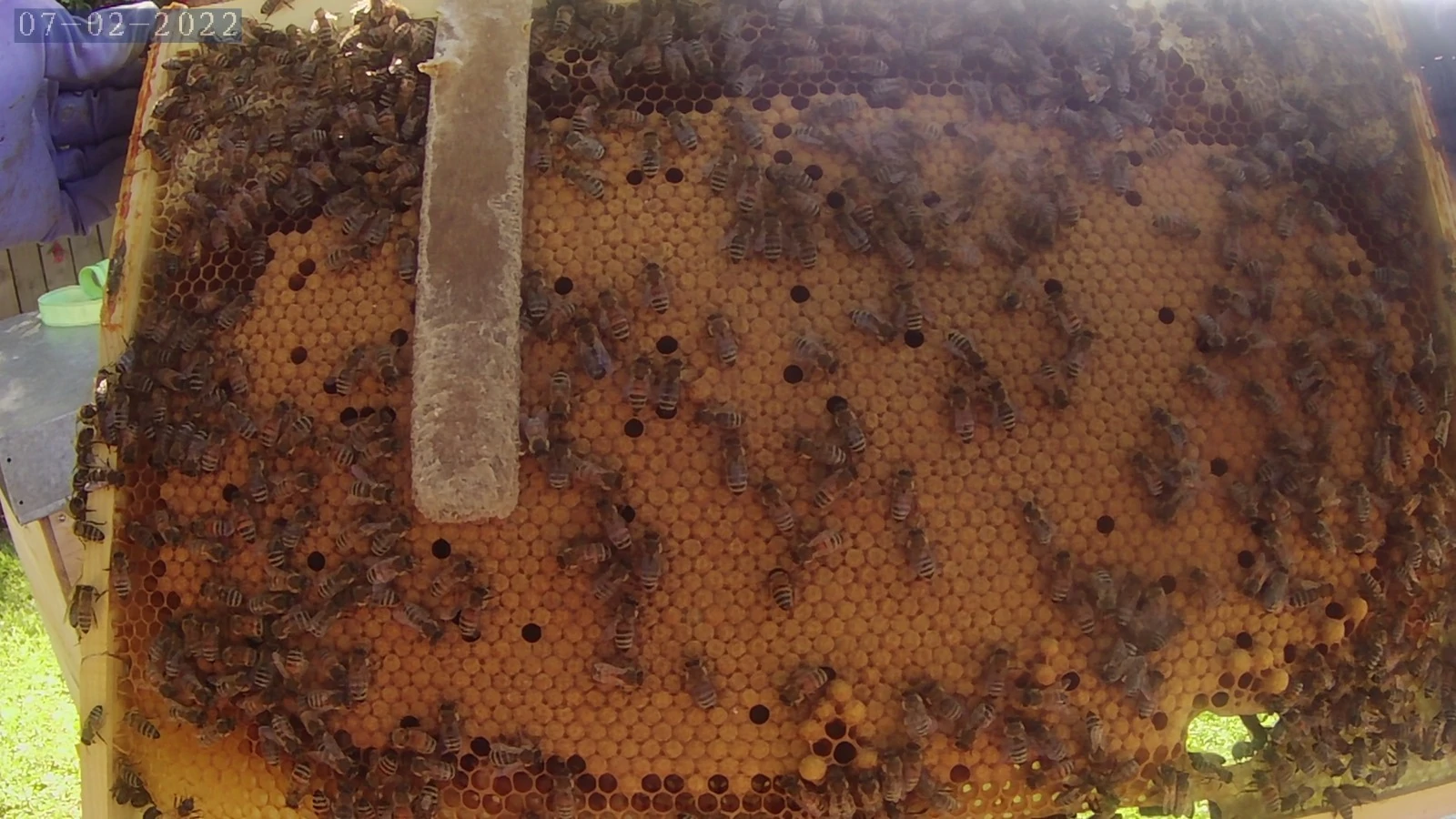It has been a discussion going on for years as to whether bees need 1 or 2 brood chambers with new beekeepers struggling to understand the pros and cons, as both sides bring up very good reasons as to why one needs 1 or 2 chambers.
In this article I will try to shed some light on the pros and cons of each style to help any new beekeepers decide. Personally, I would advise any new beekeeper to eventually try both and then decide what works best for them. Also, I have to stress out that while 1 chamber might work very well for one beekeeper there are good reasons why it might not work for another.
For now we will focus on the full depth Langstroth frame and ignore Jumbo (bigger than full depth) and 2/3 (smaller) frames for now.
Let’s start doing some maths, because that is always a good way of gathering a readers attention. Is one full depth brood box enough for a beehive?
Assuming a cell size of 5.35mm a full depth Langstroth frame will have 7000 brood cells. For a 10 frame Langstroth brood box that means 70000 brood cells in total that (theoretically) are available to the queen to lay eggs in.
How many cells will the queen need? The maximum number of eggs a healthy queen can lay has been estimated to be around 2000 eggs a day. An incredible number if you think about it! Of course, this only happens at the height of the beehive’s growth, in spring and early summer. The rest of the year the number of eggs laid by the queen will be less.
For an adult worker bee, the normal time from egg to hatching is 21 days. That means that each cell that has had an egg laid into it will be taken for 21 days, before the bee inside it hatches and the cell becomes empty again, ready for the queen to lay another egg.
If we multiply the 2500 eggs per day with 21 days, we get 42000 cells as the total maximum number of brood cells that the queen will require. Any more cells than that simply will not be able to be used by the queen.
Judging by these numbers it sounds as if 1 brood chamber would be more than enough for a beehive wouldn’t it?
Well as it turns out bees do not only use the cells in the brood chamber for rearing their brood but it also fulfils other important functions.
- Storage of pollen
- Storage of Food/Honey. Usually at the outer corners of the frame
- Drop off of fresh harvested nectar by the foragers that is then further processed by the worker bees inside the colony and eventually moved upwards towards the honey supers.
This means that Honeybees most of the time do not utilize the entirety of a frame for the rearing of brood. Below is a good picture of a very typical brood frame showing what I mean:

This photo was taken from a full depth single brood box hive at the beginning of December. Note that we had quite cold weather around that time during this season. I also used a ventilated bottom board for this hive, meaning that underneath the hive there was no insulation. In such cases I often find hives to not want to rear brood in the bottom 2 to 3 centimeters of a frame until it gets warmer. Insulation of the bottom board does not make much of a difference as cold air can enter through the entrance
It is hard to see but in the center of the frame the brood nest reaches up to the wooden top bar, while the top left and right corners have some honey in them.
Also note that there is not that much pollen stored on this frame as it has all been used up.
Overall, one can assume that about 75% of this frame have been utilized for the rearing of brood. Running with this number means that the 42000 cells that the queen will need will be provided by 8 full depth Langstroth frames (utilized to 75%). This matches pretty much exactly what one will see when running with a single brood chamber. 8 Frames will have brood on them, with the outermost 2 usually being used for honey and pollen. This by the way is due to inadequate isolation of the standard Langstroth hive. But I will get to that in another blog post.
Anyway, mathematics mixed with our practical observation have proven that single brood chambers will work.
There are a few “buts” and “what ifs”
Going back to the above picture, there are around 5000 bees hatching from this frame within the next few days. In this case there were 5 more frames like this and a few with open brood and pollen. So, 25000 Bees hatching over the course of 2 weeks. Generally speaking, 10000 bees will be required to fill 1 full depth box with 10 frames. This means that the bees that will hatch within the next 2 weeks will be able to fill an additional 2 boxes. Of course, many old bees will die off in the same timeframe alleviating the issue but this hive desperately needed a honey super (or brood box) to give more space.
This is also why beekeepers will often see such an explosive development of their bees in spring. With hives going from “not that many” to ready to swarm within a few short weeks.
New beekeepers that are unaware of this explosive growth will often struggle with this. In those cases, running with 2 brood chambers will give them some breathing room as the extra (“unused”) space can act as a buffer.
The same issue will arise when there is a honey flow, especially early honey flows. Early in late winter/spring you run your hive with just the single brood chamber and everything looks fine. But suddenly a honey flow starts (and it is not that these are announced in the newspaper), and the bees start bringing in nectar. Where should they put it? The only place they can put it is the brood chamber, as there is hardly any other space available. This will decrease the available space for the queen to lay below the 42000 cells which will give 2 results. The spring development of the hive will slow as less new bees are being reared and induce a pretty strong swarming impulse. Again with 2 brood chambers there will be more space for bees to store these early flows and utilize them to rear more brood.
Overwintering is another issue
In Autumn your hive will require some stores, either from a late honey flow or you feeding sugar syrup. For a single it can be possible to overfeed them because the hive needs both store enough honey/sugar as well as still give enough space to rear a much more limited amount of brood. This can lead to the hive not having enough stores to make it through winter. As for a double brood chamber there is again much more space to store extra honey/sugar reducing the risk of them running out.
Generally speaking, 2 brood chambers is a lot more forgiving.
Disadvantages of two brood chambers
Whenever you have to inspect the hive, or search for the queen or literally do anything, you have to deal with 20 frames (instead of 10) unless you are only doing a partial inspection.
The frames between the brood chambers will often have burr comb and wax bridges between them (much more than between honey supers) making the separation of the brood chambers a major hassle. Often did I lift up the top brood chamber with my hive tool only for all 10 frames of the bottom chamber to be lifted up at the same time. This made separating both brood chambers (a step you have to do if you want to fully inspect the hive) a tedious job and each time I squished 10s of bees in the process, which caused a lot of alarm pheromone to be released.
As for the giving of additional Honey supers, this can be a bit more problematic with 2 brood boxes. Especially if the top box already contains a lot of honey any box you put on top of it often gets ignored by the bees (especially if it only contains foundation). With single brood boxes this is much less of a problem. Adding additional supers will also be a topic for a future blog post.
I personally find working with single brood chambers much more relaxing in this regard.
As for the drawbacks outlined above, it essentially comes down to how often you can inspect your hives. For me, as a hobbyist I don’t have a problem with weekly inspecting my hives, on the contrary, I can’t wait till a week has passed. My hives are located in my backyard, further enabling me to check on anything and quickly react to any issues. Thus, the extra breathing room that a 2 brood box hive would give me is not needed for me.
Practically that means there are 2 things that I do that other beekeepers might not need to:
I give the first honey super incredibly early, pretty much as soon as I see the first nectar being deposited in the brood nest. So far with great success the bees usually take hold of it within 24 hrs and start depositing honey. This is a sign to me that adding that super was the right choice.
I keep track of the stores each hive has over the winter and give additional honey/sugar/syrup if they are running low (which they usually will by early spring)
So generally, I would say people that have many hives that are located far away, so they will not be able to inspect them as often will probably want to go with 2 brood chambers, especially if they do not feel as secure yet with “reading the hive”
Beekeepers that do not need the extra “breathing room” certainly could enjoy the advantages a single brood chamber gives them and I would advise them to at least give it a try with one hive and see how they go.
Also, there is another alternative that acts as somewhat of a compromise:
The Langstroth Jumbo Frame
It is basically a standard Langstroth single deep frame that has been extended to have roughly 30% more space, and requires bigger boxes.
These frames tend to be a bit heavier individually but can still be handled well enough. The bees like them and create a nice continuous brood nest that is not slightly squished in height.
The extra 30% of space can act as a buffer alleviating the issues outlined above, while you still only have to deal with one broodbox and 10 frames.

There only are 2 drawbacks with those frames:
They are not as commonly used in New Zealand
They require different frames for your honey supers, as jumbo honey supers is not feasible, they would simply be too heavy.
However, if you already use shallow honey supers with full depth brood chambers this will not change anything for you. On the contrary you will end up with a system that is both easy to use and practical.
By the way, single brood chamber with jumbo frames and shallow honey supers is a system that many European beekeepers (commercial and hobbyists alike) have been starting to use in the recent years.